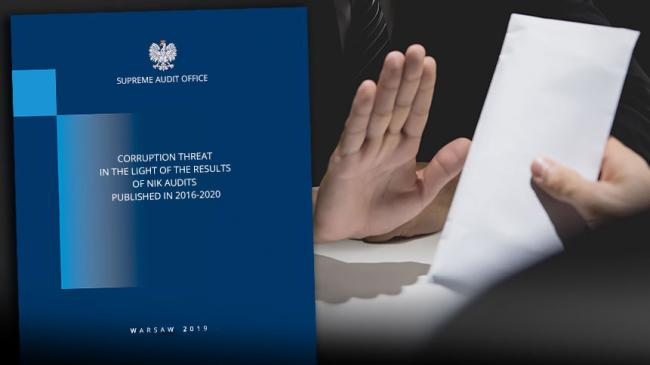The study was presented to the Sejm Committee on State Audit on 9 December – exactly on the date announced by the UN as the International Anti-Corruption Day. It includes an analysis of the corruption threat in the light of the results of NIK audits conducted in the past five years.
NIK’s anti-corruption activity –inspired by the Committee on State Audit – has been carried on for over 20 years now. As a result, numerous analyses based on the audit results were submitted to the Sejm. The Committee said it expected NIK to continue carrying out such audits to identify corruption cases and mechanisms fostering corruption.
In the past two decades, NIK’s activity has contributed considerably to a decrease in the corruption threat in Poland. The key law changes, aimed to curb corruption, inspired by NIK’s anti-corruption analyses and recommendations, included above all:
- implementation, transparency and gradual extension of the obligation to submit declarations of assets by public officials;
- limitation of excess salaries in state-owned companies in the Public Sector Salary Cap Act;
- implementation of anti-corruption changes in the Police, e.g. a ban on sponsoring the Police by individual donors, introduction of calculators of fines for road offences,
- introduction of credit fines and a ban on police officers to have their own money during roadside inspections;
- implementation of anti-corruption changes in customs services;
- implementation of the Public Procurement Act and changes providing more transparency in this area;
- structuring the issue of location of some facilities (e.g. supermarkets and wind turbines);
- adoption of anti-corruption measures in the road test system (e.g. that tests need to be carried out in the presence of third parties);
- implementation of registers of persons waiting for medical services, as a way to curb corruption risk in the healthcare system.
NIK’s model of anti-corruption activity
The Supreme Audit Office has also developed its own anti-corruption model. NIK has stressed there, first of all, that corruption should be treated broadly, as an abuse of one’s public function for illegal private gains.
The core of the model is the slogan: “Just prevent” - chiefly revealing the system causes of that threat. NIK has singled out four mechanism fostering corruption. These are irregularities which increase the risk of corruption:
- arbitrariness of action
- conflict of interests
- no transparency of action
- poor control or absence of control.
NIK has also pointed to four types of activity, particularly threatened with corruption:
- making arbitrary decisions
- contracts between the public and the private sector
- exercising supervisory and control functions by public authorities
- distribution of scarce commodities by public authorities.
Mechanisms fostering corruption based on examples taken from specific audits
In a range of its audits NIK has identified examples of mechanisms fostering corruption and corruption threats. The mechanisms or procedures needing improvement included among others the audit of outsourcing used by public hospitals in 2012-2014. What NIK found in that audit was the arbitrariness of action and insufficient control of the outsourcing process.
An interesting example is the audit of severance payments for managerial staff in strategic companies of the State Treasury in 2011-2017. The report revealed that some officials could make undue private gains at the cost of public property.
Conclusions of the Supreme Audit Office
The review of 2016-2020 audit results has shown a huge drop in the corruption threat in important sectors of the state, the tax administration in particular. The structuring and strengthening of the tax control system not only had impact on a substantial increase in the state revenue (especially from VAT) but also resulted in a major drop in the risk of mechanisms fostering corruption in the activity related to tax collection.
NIK has underlined that at the same time, though, there are still some institutions with no anti-corruption mechanisms in place. A serious corruption threat still exists with regard to using expert and advisory services by public institutions. Subsequent NIK audits and reports show that such services are often commissioned in an arbitrary way, often in the cases where a given task could be performed using the institution’s own staff. Outsourcing can be easily used for illegal private gains at the cost of the public property.
An area which continues to be significantly threatened with corruption is the construction supervision in a broad sense, including the location of construction investments or prevention of construction without a permit. Arbitrariness of actions is quite common in this area. Also, the supervision and control system is often not effective and does not guarantee equal treatment of all entities which makes it difficult to prevent corruption.
A serious corruption threat is still present in the area of local governments. Subsequent NIK audits indicate arbitrariness of actions taken by the communes in terms of enforcing the payment of local taxes. Proceedings in those matters are determined only by the will of local government officials, which may foster corruption. It is difficult to eliminate that threat considering the structural position of the local government and its limited control capacity.
NIK has been also alarmed by some irregularities in the border control on the Eastern borders of Poland, being at the same time the EU borders. A particularly threatening mechanism is the arbitrariness of actions in some cases of bringing waste to Poland (where it remains uncertain that the waste is properly disposed of in the end).


